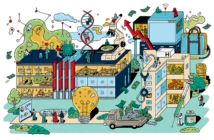Doctors can help design better electronic records.
“And, we’re down.”
Amid the Halloween costumes, there was an eerie silence. No typing, no clicking, no mouse-shuffling. Just a bunch of medical professionals, ironically dressed as the Minions, staring at each other. The electronic medical record system had crashed, and we had to run the emergency room on paper.
I shuffled around the secretary’s desk looking for a makeshift chart. I selected a manila folder, and pulled out the papers. The layout was foreign. There were no links, no graphs, no interface. Just me, the Minions, and these pieces of paper. I looked up, and found one of the attending physicians smiling at me.
The lens through which I learned medicine was inherently digital. To me, charts are not folders or papers; the term “chart” represents an ecosystem of dynamic vitals, laboratory results, notes, and orders. Hundreds of lab results are displayed, shuffled, filtered at will; years of data are condensed into graphs. A patient no longer simply has a physical presence—she has a cyber-physical one.
Are trainees becoming a bunch of Minions following numbers instead of patients?
At its core, the medical interaction relies on human pattern recognition, and recent advances in medical technology enhance this capability. Using the electronic medical record (EMR), providers can rapidly synthesize information without having to first aggregate the data. As a result, physicians can spend their time using the EMR’s output—graphs, patterns, etc.—to inform medical management. In this scenario, a well-designed EMR enables the doctor to spend more of her time physically with the patient. As such, the EMR should seamlessly integrate into the background of medical care.
Yet the reality of EMRs is somewhere in between my description and the old world of manila folders. Current EMR platforms rely heavily on the end user to input the data. Due to the clerical burden, trainees spend 20 percent of their time at the keyboard and just 12 percent physically with their patients. I can personally attest to spending just as much time charting as I do counseling my patients.
At a system level, there are too many data standards for efficient back-office integration. Each EMR has its own user interface, data input requirements, and document writers; one system cannot freely communicate with the other. This data environment creates the illusion that a single EMR holds all the patient information when, in fact, there are several missing sources. The burden of verification is therefore shifted to the end user, who must learn multiple systems and personally integrate the information.
This is where the new generation of physicians should step in. As digital natives, we represent the intersection between technology and medicine. First, we need to focus on improving data integration. Some examples include automatic approval and integration of outside records upon patient transfer, streaming vital signs entry, and real-time diagnostic imaging upload. Together, these would greatly improve the information experience of the end user, which would, in turn, improve patient care.
Second, there is a booming medical technology industry. Many companies are developing third-party devices that integrate the newest sensor technology with medical platforms. We should insert ourselves into this design process to help create a product that improves the joint experience of the physician and the patient.
So, my fellow Minions, let us drive the change we need to see in our medical system.




